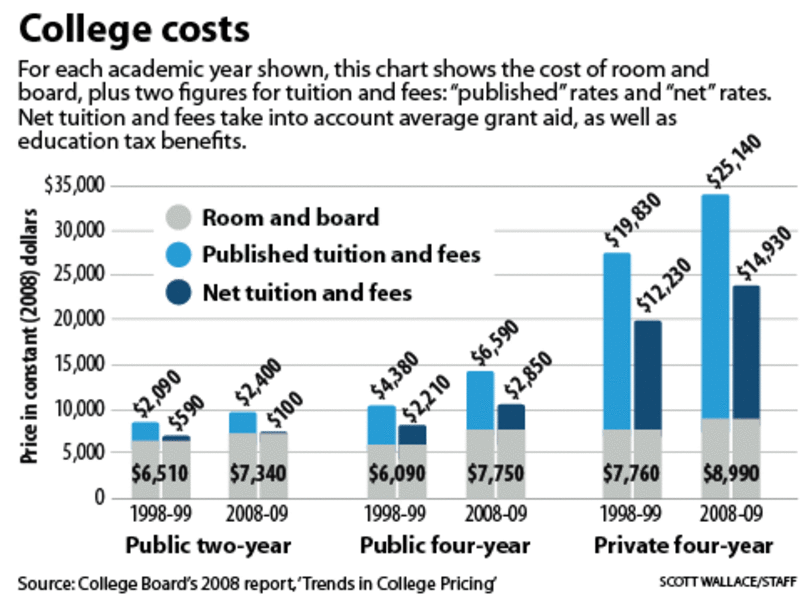Wobbly time for college tuition
Loading...
In response to mounting public frustration, colleges and universities – along with government officials – have been trying to rein in prices and boost financial aid. For this academic year, the average sticker price of four-year colleges was up less than 1 percent over inflation, and financial aid was up about 5.5 percent over inflation in 2007-08.
The data come from two annual reports released Wednesday by the College Board, a nonprofit association in New York. But those glimmers of hope look less shiny when considering that the Consumer Price Index, a measure of the inflation rate, was up 5.6 percent during the period that college prices were evaluated.
Any good news now also seems overshadowed by an economic downturn that, if not reversed fast, is expected to lead to tuition spikes – as early as next semester in some states.
"It's certainly a relief that college prices didn't rise more rapidly than other prices this year," says Sandy Baum, senior policy analyst at the College Board and coauthor of the reports. But "what's important is the whole picture of … college affordability: You have to look at what's happening to incomes, and … the nontuition costs associated with college, and the student aid available to help people pay."
National averages can mask a wide range in prices. These reports show regional differences, and for the first time they give breakdowns such as the average price at public doctorate-granting universities ($7,307) versus publics that grant only bachelor's degrees ($5,604).
On the financial-aid side, the number of low-income students who received federal Pell Grants rose 5 percent, to 5.4 million in 2007-08. Because Congress raised the maximum amount of the grants, the inflation-adjusted value increased for the first time since 2002-03. But the maximum Pell Grant still covers only one-third of the average tuition, fees, and room and board at public four-year colleges. Grants from public institutions have also risen since the start of the decade.
Aid isn't rising fast enough for groups concerned about college access and mounting student debt. Because of inflation, "there's even more competition for families' shrinking available cash," says Lauren Asher, associate director of the nonprofit Project on Student Debt in Berkeley, Calif.
That's one reason that families over the past decade have increasingly relied on private loans to cover some college costs. But this year's report shows that the volume of private loans declined by about 1 percent in 2007-08. That's partly because experts have urged families to maximize their use of federal loans first. And graduate students recently became eligible for more federal loans. The dip could also indicate the start of what will probably be a larger decline in private loans as a result of the credit crunch, Ms. Baum says.
One new policy that makes federal loans especially appealing: The payments that borrowers are expected to make will be proportional to their income starting in July 2009. "You can now count on having a loan payment that won't put you in the poorhouse," Ms. Asher says. While it makes sense to shop around for the best college options, she says, federal loans are worth considering if they can help a student attend full time or work less than 20 hours a week. "Being able to go full time, without stopping out, really increases your odds of actually graduating," she says.
Despite the general confusion and constriction in the credit markets, the government has ensured that federal loans are available.
Based on what's happened in past recessions, tough budget periods are now anticipated at both public and private colleges. On the public side, at least 17 states have already handed down budget cuts to their higher-education systems, which "will likely mean tuition increases," says Molly Corbett Broad, president of the American Council on Education, a research and advocacy group in Washington. "Even the places where the governor is trying to protect higher education, they're still going to take a big haircut," she says.
That could lead to bigger classes; freezes on hiring, travel, and equipment upgrades; and cutbacks on library and gym hours on campuses. "It all depends on how long this downturn lasts," Ms. Broad says.





